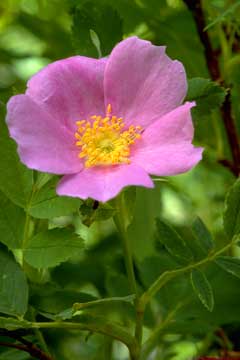 |
Nootka rose, Rosa nutkana C. Presl
var. hispida Fernald (left, right) is named for
Nootka Sound on Vancouver Island where another variety was collected by a
botanist with the Malaspina Spanish expedition (1791). Our plant’s varietal
name, hispida, means “bristly.” It grows to six feet or
more in well watered places. This plant’s compound leaves have three
to seven leaflets and are edged with fine teeth. The fruit,
“rose-hips,” may be used as an emergency food, although they consist
more of seed than pulp. The berries are rich in vitamin C, a benefit of
“rosehip tea,” used in folk medicine.
|
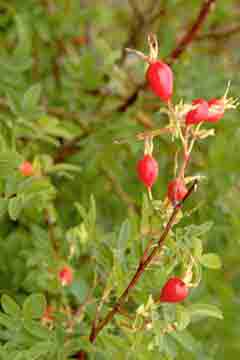 |
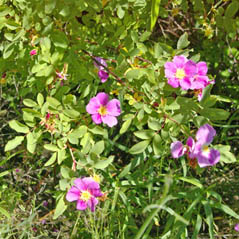 |
Another common species of rose, Wood’s Rose,
Rosa woodsii Lindl., (left) is less robust
shrub than the Nootka rose shown above. While the Wood's rose grows as high
as the foothills, it is mostly a lowland plant found throughout western United
States and Canada, east to the Mississippi River, commonly growing along
water courses. The plants have straight thorns and compound leaves with five
toothed leaflets. Its flowers, usually smaller than those of the Nootka rose/
They are attractive, with colors ranging from a pink tinged white to deep
rose-red.
Dog-rose, Rosa canina
L, an import (not shown), grows as a roadside plant
in some parts of the country including northern Idaho. It is easy to distinguish,
for its thorns are curved, whereas those of our native roses are straight.
|
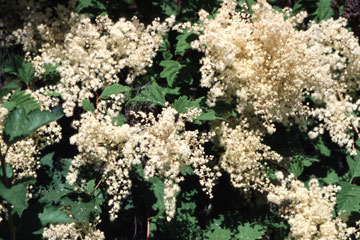 |
Hillside ocean spray, Holodiscus
discolor (Pursh) Maxim.
(left). Each spring the Clearwater River Gorge is alive
with ocean spray shrubs in bloom—and they would have been while Lewis
and Clark were camped nearby, in today’s Kamiah. Most likely it was
Meriwether Lewis who collected a specimen on May 29, 1806. Ocean spray is
an attractive spring-blooming bush whose dependent clusters of tiny off-white
flowers make a handsome ornamental plant. The scientific name, Holodiscus
discolor, with its two “discs,” is easily explained. The
first “disc” in the generic name refers to the flower’s annular
disk or “hypanthium,” a family characteristic. The second
“disc” in discolor refers to its two-colored leaves, green
on top and silvery gray beneath.
Mallow-leaf ninebark, Physocarpus
malvaceus (Greene) Kuntze
(right) is a common shrub in our mountains, growing to
fairly high elevations. Circumscribed clusters (“corymbs”) of flowers
grow on the ends of many small branches; these, as well as the plant’s
rough and peeling bark (whence “ninebark”), help to identify it.
The species name malvaceus means “mallow-like,”as the leaves
are similar to those of some mallows (although the leaves might as well been
referred to as “maple-leaf-like”). |
 |
 |
Sub-alpine spirea, Spiraea splendens
(left).
The sub-alpine spiraea, formerly classified as Spiraea
densiflora) is a low shrub, characterized by flat-topped, dense clusters
of tiny pink flowers ("corymbs"). The deciduous leaves are simple and
edged with fine teeth. The variety illustrated here grows only in the mountains
of the American West, usually on rocky ground and often in moist places (
photographed in Central Idaho's Sawtooth Mountains). There are many species
of spirea; understandably These attractive plants, native to the Northwest,
Nevada and California, are often grown in ornamental gardens.
Shiny-leaf , or white spirea, Spiraea
betulifolia Pallas (right)
grows in most of our northern and eastern states as well as in western Canada.
It is characterized by white or pinkish flowers (some are post-mature
in our illustration) and toothed leaves. It grows to treeline in Idaho,
preferring rocky hillsides. The species name, betulifolia, means
"birch-leaves" for their similarity. |
 |
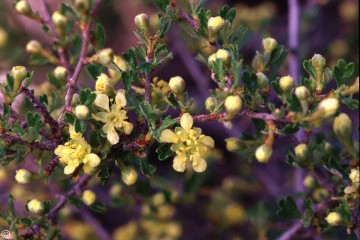 |
Bitterbrush, Purshia
tridentata (Pursh) DC. (left).
The bitterbrush (also antelope-brush) can be confused with the shrubby
cinquefoil, although it blooms earlier, has smaller, quite different flowers,
and three-toothed (tridentata) leaves. The plant is usually found
with sagebrush, often high in our mountains. It is an important browse
plant for deer and antelope. The name Purshia honors Frederick Pursh (1774-1820)
the botanist who classified specimens returned by the Lewis and Clark expedition.
Meriwether Lewis collected the plant on the same day as the shrubby
cinquefoil.
Shrubby cinquefoil, Dasiphora fruticosa
(L.) Rydb. (right) blooms from early summer through
August blooming on sagebrush slopes, high on alpine tundra, Dasiphora
from the Greek implies“thick foliage,” fruticosa from the
Latin means “shrubby,” and “cinquefoil,” from the French,
means “five-leaved,” for the plant’s five-fingered leaves
(an older name, “golden hardhack,” has also been suggested as a
common name for the plant). The shrubby cinquefoil, known to nurserymen as
"potentilla"--is a European variety. often used in landscape gardening.
Meriwether Lewis collected a specimen of shrubby cinquefoil along Montana’s
Blackfoot River on July 6, 1806. |
 |
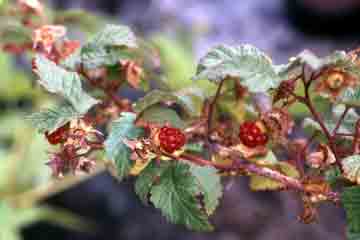 |
Common raspberry, Rubus
idaeus L. var. strigosus
(Michx.) Maxim. (leftt) is one of the most widely distributed
members of the rose family. It is found throughout North America (save in
a few southern states) as well as in Eurasia. The plants are quite at home
in our mountains and grow at least as high as treeline, fruiting late in
the summer.. Five-petaled, small white flowers are typical of those of
Rubus species. The berries are smaller than domestic fruit—hardly
surprising for they grow on unfertilized rocky ground. Nevertheless, they
taste the same as the raspberries that grow in our gardens. |
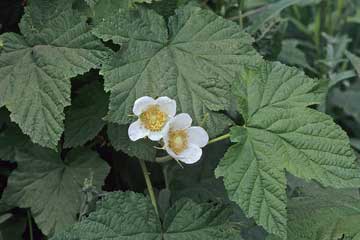 |
Thimbleberry, Rubus parviflorus
Nutt. (left, right) grows as an
“unarmed” (lacking brambles) shrub that may be six feet high. Identify
the plant by its large, deep-green, maple-like leaves, by its large white
blossoms (up to 2" across), and by its raspberry-like (although tasteless)
fruit. Lewis and Clark collected the thimbleberry on April 15, 1806, while
near today’s The Dalles, Oregon, but because their specimen was in poor
condition it could not be published as a new species. Thomas Nuttall later
found the plant on Mackinac Island, in Lake Huron, and named it
parviflorus (“small-flower”), a strange choice, for its
flowers are the largest of any of our native Rubus species. |
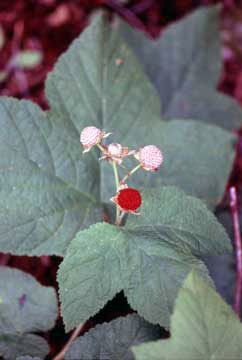 |











